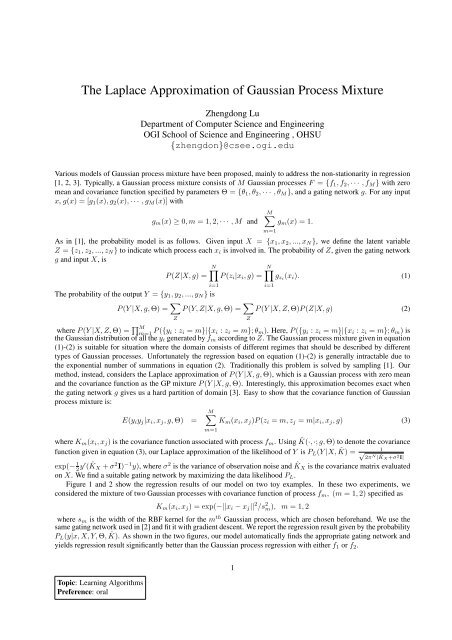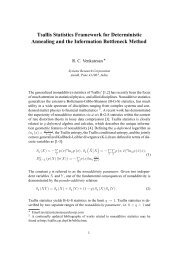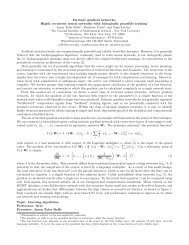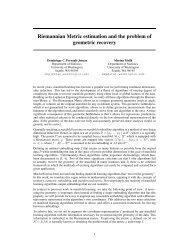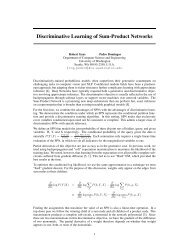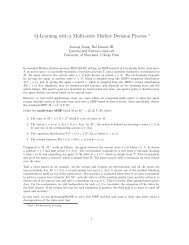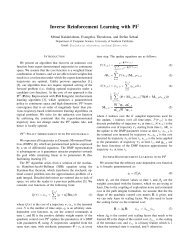The Laplace Approximation of Gaussian Process Mixture
The Laplace Approximation of Gaussian Process Mixture
The Laplace Approximation of Gaussian Process Mixture
Create successful ePaper yourself
Turn your PDF publications into a flip-book with our unique Google optimized e-Paper software.
<strong>The</strong> <strong>Laplace</strong> <strong>Approximation</strong> <strong>of</strong> <strong>Gaussian</strong> <strong>Process</strong> <strong>Mixture</strong><br />
Topic: Learning Algorithms<br />
Preference: oral<br />
Zhengdong Lu<br />
Department <strong>of</strong> Computer Science and Engineering<br />
OGI School <strong>of</strong> Science and Engineering , OHSU<br />
{zhengdon}@csee.ogi.edu<br />
Various models <strong>of</strong> <strong>Gaussian</strong> process mixture have been proposed, mainly to address the non-stationarity in regression<br />
[1, 2, 3]. Typically, a <strong>Gaussian</strong> process mixture consists <strong>of</strong> M <strong>Gaussian</strong> processes F = {f1, f2, · · · , fM } with zero<br />
mean and covariance function specified by parameters Θ = {θ1, θ2, · · · , θM }, and a gating network g. For any input<br />
x, g(x) = [g1(x), g2(x), · · · , gM (x)] with<br />
M<br />
gm(x) ≥ 0, m = 1, 2, · · · , M and gm(x) = 1.<br />
As in [1], the probability model is as follows. Given input X = {x1, x2, ..., xN}, we define the latent variable<br />
Z = {z1, z2, ..., zN} to indicate which process each xi is involved in. <strong>The</strong> probability <strong>of</strong> Z, given the gating network<br />
g and input X, is<br />
N<br />
N<br />
P (Z|X, g) = P (zi|xi, g) = gzi(xi). (1)<br />
i=1<br />
<strong>The</strong> probability <strong>of</strong> the output Y = {y1, y2, ..., yN} is<br />
P (Y |X, g, Θ) = <br />
P (Y, Z|X, g, Θ) = <br />
P (Y |X, Z, Θ)P (Z|X, g) (2)<br />
Z<br />
where P (Y |X, Z, Θ) = M m=1 P ({yi : zi = m}|{xi : zi = m}; θm). Here, P ({yi : zi = m}|{xi : zi = m}; θm) is<br />
the <strong>Gaussian</strong> distribution <strong>of</strong> all the yi generated by fm according to Z. <strong>The</strong> <strong>Gaussian</strong> process mixture given in equation<br />
(1)-(2) is suitable for situation where the domain consists <strong>of</strong> different regimes that should be described by different<br />
types <strong>of</strong> <strong>Gaussian</strong> processes. Unfortunately the regression based on equation (1)-(2) is generally intractable due to<br />
the exponential number <strong>of</strong> summations in equation (2). Traditionally this problem is solved by sampling [1]. Our<br />
method, instead, considers the <strong>Laplace</strong> approximation <strong>of</strong> P (Y |X, g, Θ), which is a <strong>Gaussian</strong> process with zero mean<br />
and the covariance function as the GP mixture P (Y |X, g, Θ). Interestingly, this approximation becomes exact when<br />
the gating network g gives us a hard partition <strong>of</strong> domain [3]. Easy to show that the covariance function <strong>of</strong> <strong>Gaussian</strong><br />
process mixture is:<br />
M<br />
E(yiyj|xi, xj, g, Θ) = Km(xi, xj)P (zi = m, zj = m|xi, xj, g) (3)<br />
m=1<br />
where Km(xi, xj) is the covariance function associated with process fm. Using ˆ K(·, ·; g, Θ) to denote the covariance<br />
function given in equation (3), our <strong>Laplace</strong> approximation <strong>of</strong> the likelihood <strong>of</strong> Y is PL(Y |X, ˆ 1<br />
K) = √<br />
2πN | KX ˆ +σ2I| exp(− 1<br />
2y′ ( ˆ KX + σ2I) −1y), where σ2 is the variance <strong>of</strong> observation noise and ˆ KX is the covariance matrix evaluated<br />
on X. We find a suitable gating network by maximizing the data likelihood PL.<br />
Figure 1 and 2 show the regression results <strong>of</strong> our model on two toy examples. In these two experiments, we<br />
considered the mixture <strong>of</strong> two <strong>Gaussian</strong> processes with covariance function <strong>of</strong> process fm, (m = 1, 2) specified as<br />
Z<br />
m=1<br />
i=1<br />
Km(xi, xj) = exp(−||xi − xj|| 2 /s 2 m), m = 1, 2<br />
where sm is the width <strong>of</strong> the RBF kernel for the m th <strong>Gaussian</strong> process, which are chosen beforehand. We use the<br />
same gating network used in [2] and fit it with gradient descent. We report the regression result given by the probability<br />
PL(y|x, X, Y, Θ, ˆ K). As shown in the two figures, our model automatically finds the appropriate gating network and<br />
yields regression result significantly better than the <strong>Gaussian</strong> process regression with either f1 or f2.<br />
1
g 1<br />
1.5<br />
1<br />
0.5<br />
0<br />
0 0.5 1<br />
x<br />
1.5 2<br />
(a) Output <strong>of</strong> g1<br />
y<br />
1.5<br />
1<br />
0.5<br />
0<br />
−0.5<br />
−1<br />
2<br />
K1:s =3<br />
1<br />
2<br />
K2:s =0.05<br />
2<br />
fitted K<br />
−1.5<br />
0 0.5 1<br />
x<br />
1.5 2<br />
(b) Regression result<br />
Figure 1: <strong>The</strong> regression result.(b)Blue line: true curve. Blue stars: noisy observation. Black curve: f1, s 2 1 = 3 ; Red<br />
curve: f2, s 2 2 = 0.05 ; Green curve: <strong>Laplace</strong> <strong>Approximation</strong> <strong>of</strong> mixture <strong>of</strong> {f1, f2} with fitted K.<br />
g 1<br />
1.5<br />
1<br />
0.5<br />
0<br />
0 0.5 1<br />
x<br />
1.5 2<br />
(a) Output <strong>of</strong> g1<br />
y<br />
1.5<br />
1<br />
0.5<br />
0<br />
−0.5<br />
−1<br />
2<br />
K1:s =0.5<br />
1<br />
2<br />
K2:s =0.01<br />
2<br />
fitted K<br />
−1.5<br />
0 0.5 1<br />
x<br />
1.5 2<br />
(b) Regression result<br />
Figure 2: <strong>The</strong> regression result. (b) Blue line: truth. Blue stars: noisy observation. Black curve: f1, s 2 1 = 0.5 ; Red<br />
curve: f2, s 2 2 = 0.01 ; Green curve: <strong>Laplace</strong> <strong>Approximation</strong> <strong>of</strong> mixture <strong>of</strong> {f1, f2} with fitted K.<br />
References<br />
[1] C. Rasmussen and Z. Ghahramani. Infinite mixtures <strong>of</strong> gaussian process experts. In NIPS 14, 2002.<br />
[2] V. Tresp. <strong>Mixture</strong>s <strong>of</strong> gaussian processes. In NIPS 13, 2001.<br />
[3] O. Walliams. A Switched <strong>Gaussian</strong> <strong>Process</strong> for Estimating Disparity and Segmentation in Binocular Stereo. In<br />
NIPS 19, 2007.<br />
2


